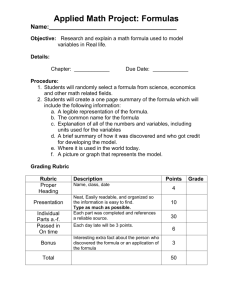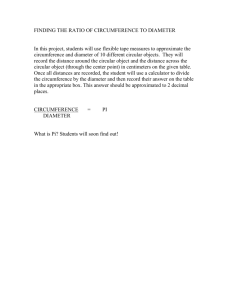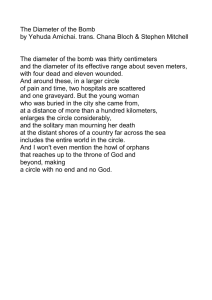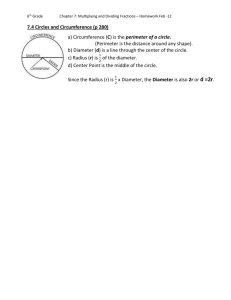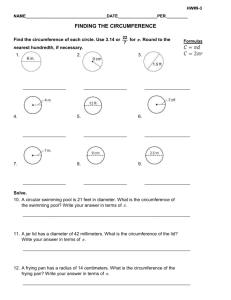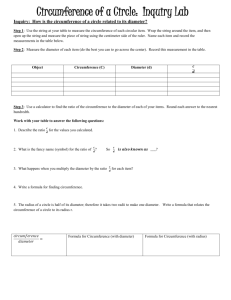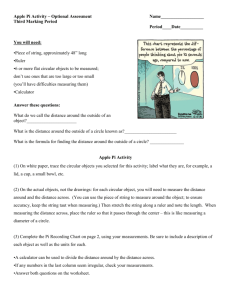Demo_Lesson_DiscoveringPi
advertisement
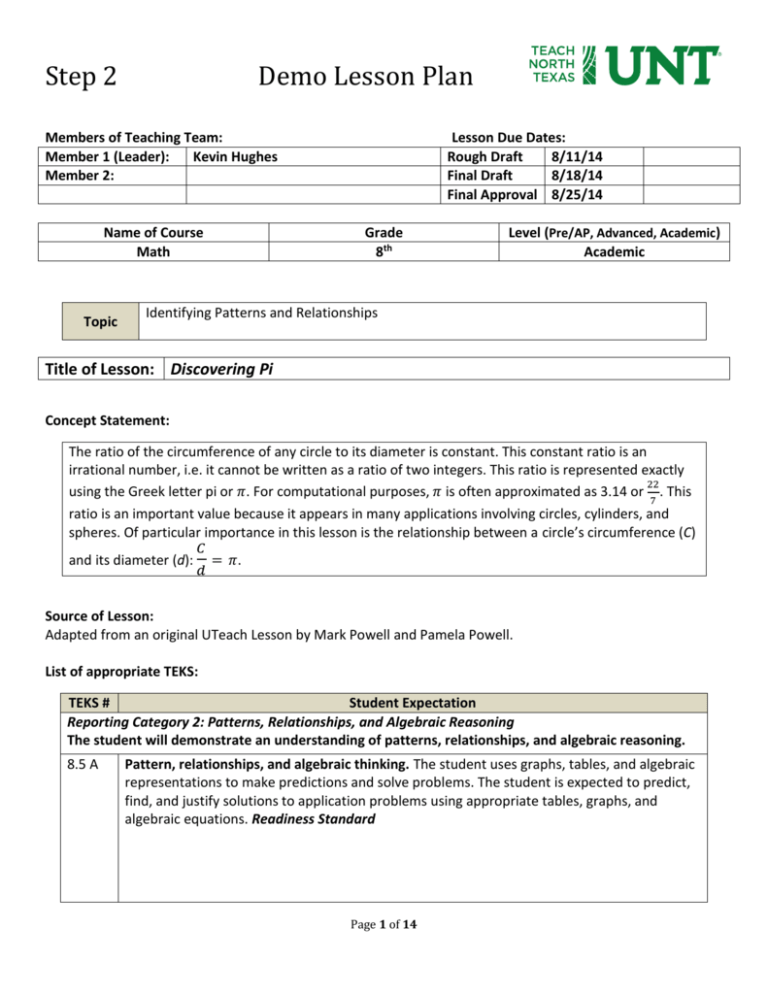
Step 2 Demo Lesson Plan Members of Teaching Team: Member 1 (Leader): Kevin Hughes Member 2: Name of Course Math Topic Lesson Due Dates: Rough Draft 8/11/14 Final Draft 8/18/14 Final Approval 8/25/14 Grade 8th Level (Pre/AP, Advanced, Academic) Academic Identifying Patterns and Relationships Title of Lesson: Discovering Pi Concept Statement: The ratio of the circumference of any circle to its diameter is constant. This constant ratio is an irrational number, i.e. it cannot be written as a ratio of two integers. This ratio is represented exactly 22 using the Greek letter pi or 𝜋. For computational purposes, 𝜋 is often approximated as 3.14 or 7 . This ratio is an important value because it appears in many applications involving circles, cylinders, and spheres. Of particular importance in this lesson is the relationship between a circle’s circumference (C) 𝐶 and its diameter (d): = 𝜋. 𝑑 Source of Lesson: Adapted from an original UTeach Lesson by Mark Powell and Pamela Powell. List of appropriate TEKS: TEKS # Student Expectation Reporting Category 2: Patterns, Relationships, and Algebraic Reasoning The student will demonstrate an understanding of patterns, relationships, and algebraic reasoning. 8.5 A Pattern, relationships, and algebraic thinking. The student uses graphs, tables, and algebraic representations to make predictions and solve problems. The student is expected to predict, find, and justify solutions to application problems using appropriate tables, graphs, and algebraic equations. Readiness Standard Page 1 of 14 Underlying Processes and Mathematical Tools 8.14 C Underlying processes and mathematical tools. The student applies Grade 8 mathematics to solve problems connected to everyday experiences, investigations in other disciplines, and activities in and outside of school. The student is expected to select or develop an appropriate problem-solving strategy from a variety of different types, including drawing a picture, looking for a pattern, systematic guessing and checking, acting it out, making a table, working a simpler problem, or working backwards to solve a problem. 8.14 D Underlying processes and mathematical tools. The student applies Grade 8 mathematics to solve problems connected to everyday experiences, investigations in other disciplines, and activities in and outside of school. The student is expected to select tools such as real objects, manipulatives, paper/pencil, and technology or techniques such as mental math, estimation, and number sense to solve problems. 8.15 A Underlying processes and mathematical tools. The student communicates about Grade 8 mathematics through informal and mathematical language, representations, and models. The student is expected to communicate mathematical ideas using language, efficient tools, appropriate units, and graphical, numerical, physical, or algebraic mathematical models. Common Core State Standards: Grade 8 Functions. Define, evaluate, and compare functions. Use functions to model relationships between quantities. CCSS.Math.Content.8.F.B.4 Construct a function to model a linear relationship between two quantities. Determine the rate of change, and initial value of the function from a description of a relationship or from two (x, y) values, including reading these from a table or from a graph. Interpret the rate of change and initial value of a linear function in terms of the situation it models, and in terms of its graph or table of values. CCSS.Math.Content.8.F.B.5 Describe qualitatively the functional relationship between two quantities by analyzing a graph (e.g., where the function is increasing or decreasing, linear or nonlinear). Sketch a graph that exhibits the qualitative features of a function that has been described verbally. Page 2 of 14 Objectives Write objectives in IWBAT form. Evaluation Questions (at least one open-ended) Each question should match the written objective. You may use one of your sample TAKS/STAAR problems as a guiding template for your evaluation questions. Note: these should be the SAME questions you are utilizing in the evaluation section. Include answers to all questions. Include 1 real-world, 1 griddable, and 1 explanation question 1 I will be able to measure the circumference and diameter of a circle. Use your ruler and string to measure the diameter and Circumference of the circular objects you are provided (in centimeters). 2 I will be able to use a table or graph of data to identify the relationship between the circumference of a circle and its diameter. I will be able to determine the diameter of a circle given the circumference of the circle. After collecting the measurements of the circular objects in the bag, what relationship do you notice between the circumference and the diameter of all of the circles you measured? Did your partner get the same results? Did your classmates get the same results? The tallest tree in the world is believed to be the Mendicino Tree, a redwood near Ukiah, California, that is 112 meters tall! Near the ground the circumference of this tree is about 9.85 meters. The age of a redwood can be estimated by comparing its diameter to trees with similar diameters. What is the diameter of the Mendicino tree? 3 Page 3 of 14 Resources, Materials, Handouts, and Equipment List in the form of a table: ITEM Quantity Source List who this is for (Specify worksheets) (How many do you need?) (Who is responsible?) (teacher, student, group) Ziploc® Gallon size Bags 1 per pair Teacher Student Pairs Tablet Computer 1 per student Teacher Student Circular items (cans, lids, Frisbees, rolls 4-6 items per pair of tapes, CDs) Teacher Student Pairs Tennis balls in a can 1 can Teacher Whole Class Yarn or String 1, 2-ft section per student Teacher Student 1 box assorted markers 1 per pair Teacher Student Pairs Rulers 1 per student Teacher Student Recording Sheet 1 per student Teacher Students Advanced Preparations: 1. Prepare a gallon Ziploc® bag of materials for each student pair. The bag should contain the following: 4-6 circular items 2 rulers 2, 2-foot pieces of yarn or string 1 box assorted markers 2. The following Google Forms should be uploaded to the teacher’s Google Drive to send out to the students: Tennis Ball Can Survey http://bit.ly/1hwvdlJ My Measurements Form http://bit.ly/1jyE4Fl Note: After submitting their measurements for the circumference and diameter of their first object, a screen will pop up with the message that “Your response has been recorded.” The students will then need to click on the hyperlink “Submit another response” to input the measurements for their next object. They will repeat these steps until they have finished entering all of their data. 3. The following Google Spreadsheets will be used to collect, display, and analyze student data: Tennis Ball Can Survey Results http://bit.ly/1mI5qKo Collected Measurements Form http://bit.ly/1hsInkS 4. The following Google Docs will be used to assess student’s understanding during the lesson: Equator Distance http://bit.ly/1cYSXyX What’s My Age? http://bit.ly/1fuTeMz 5. Check to make sure that the classroom set of tablets are fully charged and that the Wi-Fi is working. 6. Run off copies of Measurement Recording Sheet Page 4 of 14 5E Lesson Plan Objective Statement: Today we will be looking at data we collect from measuring the different parts of a circle. By the end of the lesson, we will be able to use tables or graphs to analyze our data and determine if there are any patterns that we notice. We will use the patterns we discover to determine the circumference of any given circle. ENGAGEMENT What the Teacher Will Do Hello students! My name is Mr. Hughes. “I have a can of tennis balls here. I wonder: Do you think the distance around the lid of the can would be longer, shorter, or the same length as the height of the can?” (Walk around the room holding up the can of tennis balls so that all students can see the can.) “Think about this for a minute.” “Once you’ve decided, I want you to submit your answer using your tablets and the Google form that I sent each of you. This form has three answer choices: The distance around the lid is longer; The height of the can is longer; or They would be the same.” “Respond to this survey by selecting one of the answers.” Allow students one minute to vote. “Let’s look at the conjectures that we made.” Display the bar chart representing the students’ responses in the Google spreadsheet collecting the data, Tennis Ball Can Time: 5 Minutes Probing/Eliciting Questions and Students Responses Given the can of tennis balls, do you think the distance around the lid of the can would be longer, shorter, or the same as the height of the can? Most students will exhibit some form of perceptual centration where they believe the height of the can is longer than the distance around the lid of the can simply because “it looks that way.” What the Students Will Do Before class starts, students will need to have picked up a tablet in order to complete the survey in the engagement activity. What are students doing during the engagement activity? Students will examine a can of tennis balls and make a conjecture about the distance around the lid compared to the height of the can (without measuring). Describe what the students will do. “What does the bar graph tell us about which measurement the class thinks was longer?” Only __ people said that the distance around the lid would be longer, __ people said that the height of the can would be longer, most of us said __ would be longer. “What are some ways we might be able to test our conjecture?” Use a ruler or measuring tape to measure the distance around the lid and the height of the can. Page 5 of 14 Students will utilize their tablets to enter their conjectures using a Google form. This form will collect all the student responses and create a bar graph to display the results. Students will verbalize what the graph indicates about which measurement the majority of the class thinks has the longer length: the distance around the lid or the height of the can. (Responses). “It appears that the majority of the class thinks ___ (insert what the bar graph indicates). What are some ways that we might be able to test our conjectures?” Transition Statement “We are going to actually discover an interesting relationship today that exists in all circles no matter the size of the circle. After we discover this relationship, we will come back and show which length is longer using mathematics.” EXPLORATION What the Teacher Will Do Since there are several important vocabulary terms that will be utilized within the exploration activity, it is important that the teacher assess the students’ understanding of these terms before starting the exploration activity. 1. Continue to hold up the tennis ball can (or share a picture of a can of tennis balls with the students via their tablets). 2. Ask the students what geometric shapes they notice when they look at the can of tennis balls. 3. Solicit responses from students by writing them on the board. 4. Ask other students to help with describing what a good definition of the word would be. 5. The teacher and other students can encourage mathematical dialogue by Time: 20 Minutes Probing/Eliciting Questions and Student Responses What geometric shapes do you notice when you look at the can of tennis balls? Circles (top and bottom), Cylinder (container itself), Sphere (the tennis balls), Rectangle (the walls of the cylinder when unrolled). How would you define a circle? The set of all points that are the same distance from a fixed point, called the center of the circle. What are some parts of circle that you have talked about in the past? The radius; the circumference; the diameter. How would you define what the diameter of a circle is? The diameter is the length of the line segment with endpoints on the circle and passing through the center of the circle. A common misconception held by Page 6 of 14 What the Students Will Do Students will create drawings and write definitions in their Evernote notebook for the following terms: circles, diameter, and circumference. Students will work in pairs to complete the exploration activity. The oldest student will be responsible for getting the materials for their group. They will need to collect one Ziploc® bag containing their supplies and two recording sheets for their group from the supply station. Both students in the pair will measure all of the objects in their bag. Each student will then submit their measurements using the Google Form, My Measurements. Students will need to be sure to record their measurements on asking questions or providing counterexamples to help fine tune the definitions that the class generates. 6. Words that the students will need to know for the lesson are: a. Circle b. Circumference c. Diameter d. Cylinder e. Sphere What are the directions for the exploration activity? Write them here: “You will be working with a partner to complete our investigation today. You will be collecting data on the measurements of the circumference and diameter of several circular objects. The oldest person in each pair needs to come over to our supply station and pick up a Ziploc® bag and two recording sheets.” Hold up the bag and the recording sheet. Instruct students to take their supplies out of their bags when they get them back to their desks. Review the following directions with the students: 1. Using the ruler and string in the bag, each person will need to measure the diameter and the circumference of the circular objects in your Ziploc® bag. This means all of the objects will be measured twice – once by students is that a formula defines a geometric object. For example, rather than provide a definition of what the radius of a circle is, students will simply state, “The radius is half of the diameter.” While this does correctly describe the relationship between the radius and diameter of circle, it does not indicate what the defining characteristics of a radius of a circle are or how to describe it using their own language. How would you define what the circumference of a circle is? The circumference of a circle is the distance around the circle. Again, students will often simply recite the formula for computing the circumference of a circle from the STARR formula sheet instead of the definition of circumference. How could we start looking for a pattern? Try adding, subtracting, multiplying, or dividing the diameters and the circumferences to look for a repeated result…. Look at a change between the diameters of two circles and see if there is corresponding change in the circumferences. Graph the data. What relationships are you finding in the data on the table? The circumference is approximately three times the length of the diameter. The diameter is approximately one-third of the length of the diameter. Page 7 of 14 their recording sheets before entering the data into the Google form. That way, if they lose their connection to the Internet they will not lose all of the data they have collected up to that point. If a student pair finishes submitting their data early, they can begin looking at the data they collected on their recording sheets. They need to look for patterns that may exist between the measures they recorded. Once all students are finished submitting their measurements, they will receive a spreadsheet through Google drive. Students will examine the class data to determine a relationship between the measurements. Students may find it helpful to plot their data points using the Google spreadsheet functions. 2. 3. 4. 5. 6. you and once by your partner. Don’t simply copy your partner’s measurement. You have to actually measure the circumference of each circle – do not use your formula for circumference. Record your measurements on the recording sheet as you go along. Once you are finished measuring, you will submit your measurements using the Google Form, My Measurements. If you finish early, you and your partner can look over your recording sheets. Begin looking for patterns in the data you collected. Once everyone is finished submitting their data, you will receive a spreadsheet with all of the measurements the entire class collected. Examine this data. What patterns do you notice in the data in the table? Plot your data using the Google spreadsheet. What do patterns do you see now? What patterns do you notice when you plot your data points? They appear to form a straight line. “How might we use the string in your supply bag to help you find measurements on the circle?” While students are working on the exploration activity: Page 8 of 14 Move around to each group and check to make sure they are measuring correctly and recording their measurements on their paper before submitting them via the Google form. Suggest that students look at both the tabular and graphical representation of the data. Students can use their stylus to draw a line through the data points. The y-intercept of this line is located at approximately (0, 3.14). Transition Statement “Let’s take a look at the class data and the conjectures your groups have come up with and see if we notice anything about the data.” EXPLANATION What the Teacher Will Do Display the Google spreadsheet of the data collected for the entire class. Have students enter their formulas into a separate spreadsheet column to verify their conjectures. Facilitate a discussion of the results the students obtained. The significant piece of the exploration activity is students recognizing that the ratio of a circle’s circumference to its diameter is always a little more than 3. This constant ratio was given a special name Time: 10 Minutes Probing/Eliciting Questions and Student Responses What patterns and relationships did you find between the diameters and circumferences of the different circles? The circumference is about three times the diameter. What is a ratio? A comparison of two numbers. What two numbers are we comparing here? A circle’s diameter and its circumference. How can someone use the term ratio to describe what we’ve discovered so far? Page 9 of 14 What the Students Will Do Students will compare their data with the data collected by the entire class. Using the entire class data, students will be able to examine and test their conjectures that they made working in pairs. Students will develop ways to refine their computations for the ratio of the circumference of a circle to its diameter. and symbol: the Greek letter π (pi). Guide students in utilizing the spreadsheet to calculate the class mean. Reinforce that the ratio of the Circumference of a circle to its diameter is a constant and represented by 𝜋. The ratio of a circle’s circumference to its diameter is a little more than 3. Did every group get exactly the same number for this ratio? No. They are all close to 3, but not all the same. Why are the ratios all different? Because we are measuring, and measuring always requires some estimation. We may have measured incorrectly… How could we decide on a class value for the ratio of the circle’s circumference to its diameters? Find the average. Using the average of several measurements will help to eliminate rounding errors. What does 𝜋 represent? The ratio of the circumference of a circle to its diameter. Transition Statement Now that we know what π represents. Let’s look at how we can use this relationship to answer a real-world question. ELABORATION 1 What the Teacher Will Do Send the following prompt to the students on their tablets: The diameter of the Earth at the equator is approximately 12,756 km. Explain how you could use what you just discovered about 𝝅 to find Time: 5 Minutes Probing/Eliciting Questions and Student Responses What information are we given in the prompt? The diameter of the Earth is approximately 12,756 km. What are they asking us to find? The distance around the Earth at the Page 10 of 14 What the Students Will Do Students will utilize their tablets to access the Google Doc, Equator Distance. Students will highlight important information in the prompt. Using their stylus, students will the distance around the Earth at the equator. Use the guiding questions to have students determine what information is provided in the prompt and how they might find a solution to the prompt. It might help to take an extra tennis ball and cut it in half so students visualize what the cross-section of the Earth would look like if it were sliced in half at the equator. [Interesting fact: The Earth is not a perfect sphere. The diameter of the Earth at the equator is 12, 756 km, but the diameter of the Earth measured at its poles is 12,713 km.] equator. write a response to how they would find a solution to the question. What geometric shape is the Earth? A sphere (like the tennis balls). If we were to slice the Earth in half at its equator, what shape would we have at the cross-section? A circle. How would the distance around the Earth’s equator be related to this circle? The distance around the Earth’s equator would be the circumference of this circle. How could we use what we discovered about 𝜋 to help use find the distance around the Earth? Since 𝜋 is the ratio of the circumference of a circle to its diameter, we can write 𝐶 = 𝜋 12,756 If we multiply 𝜋 by 12,756, we can find C. If we use 3.14 as an approximate value of 𝜋, what would be the approximate distance around the Earth at the equator? (12,756 𝑘𝑚)(3.14) = 40,053.8 𝑘𝑚 Transition Statement Let’s go back to the question I asked you at the beginning of class and see how we can show whether the distance around our tennis ball can is longer/shorter than the height of the can. Page 11 of 14 ELABORATION 2 What the Teacher Will Do Show the class the can of tennis balls again. “I want you to take a minute to think about how you might draw a picture to model this can with the tennis balls in it.” “Use S-Note on your tablet to draw a picture to represent the can with the three tennis balls inside of it.” Ask guiding questions to determine the algebraic representations for the distance around the lid of tennis ball can and the height of the can in terms of the diameter, d, of the can. Extend the situation to have students consider why the cylinder might be the best choice for packaging as opposed to using a squarebased prism for the packaging. Time: 10 Minutes Probing/Eliciting Questions and Student Responses How would you draw a picture to represent the can with the three tennis balls inside? What the Students Will Do Students will utlize S-Note on their tablets to draw a model of the tennis ball can. As the teacher guides students to consider the different algebraic representations of the measures of the tennis ball can, students will record these measures and write brief descriptions on their notes. What geometric shape is the lid of the tennis ball can? A circle. What would be the distance around the lid? The distance around the lid would be the circumference of the circle. So, if d is the diameter of the lid, the circumference is 𝜋𝑑. How would the diameter of the sphere compare to the diameter of the cylinder? The diameter of each sphere would be congruent to the diameter of the cylinder. So the diameter of the spheres would be d. If we draw the diameter of each sphere so they are parallel to the sides of the tennis ball can, how tall would the can be in terms of the diameters of the spheres? The height of the can would be 𝑑 + 𝑑 + 𝑑 or 3𝑑. How does the distance around the lid Page 12 of 14 Students will consider why a manufacturer might choose to use a cylinder to package their tennis balls as opposed to a square-based pyramid. Students will justify their ideas. compare to the height of the can? Since 𝜋 > 3, 𝜋𝑑 > 3𝑑. This means that the distance around the lid of the can (𝜋𝑑) is greater than the height of the can (3d). Why would a manufacturer choose to package their tennis balls in a cylinder as opposed to a prism with a square base measuring 𝑑x𝑑? The surface area of the cylinder would be 3.5𝜋𝑑2 . The surface area of the prism with a square base would be 14𝑑2 . Using a square-based prism would require more material to build since 14𝑑2 > 3.5𝜋𝑑2 . This extra material would increase the cost to produce the packaging, which would cut into the company’s profits. Transition Statement Let’s summarize what we have investigated and discovered today. Closure Statement Today we have analyzed data using tables and graphs to identify a relationship that exists between the circumference of a circle and its diameter. We discovered the ratio of the circumference of a circle to its diameter is constant and represented by a special letter, called 𝜋. Page 13 of 14 EVALUATION What the Teacher Will Do The teacher will allow 5-10 minutes for the post-test. Using the special relationship you discovered for the ratio of the circumference of a circle to its diameter, you are going to use this ratio to help you solve a problem. Time: 5-10 Minutes Probing/Eliciting Questions What ratio did we talk about today? Ratio of the circumference of a circle to its diameter. 𝜋 How could we write this relationship using variables? 𝐶 =𝜋 𝑑 You have a real-world situation described on your Exit slip. Take a minute to identify what information you are given in the problem. Then, try to use this relationship to find a solution to the question. Page 14 of 14 What the Students Will Do Students will utilize their tablets to access the Google Doc, What’s My Age? This is their exit ticket for the day. Students will find a solution to the following prompt: The tallest tree in the world is believed to be the Mendicino Tree, a redwood near Ukiah, California, that is 112 meters tall! Near the ground the circumference of this tree is about 9.85 meters. The age of a redwood can be estimated by comparing its diameter to trees with similar diameters. Explain how you could find the diameter of the Mendicino tree? If 𝝅 is approximately 3.14, what is the diameter of the Mendicino tree? Since 𝜋 is the ratio of the circumference of a circle to its diameter, we can write 9.85 = 𝜋. 𝑑 If we multiply 𝜋 by d, we can have 9.85 = 𝜋𝑑. Dividing both sides by 𝜋, we have 9.85 = 𝑑. 𝜋 If we use 3.14 as an approximate value of 𝜋, the approximate diameter of the tree would be 9.85 ≈ 3.14. 3.14
